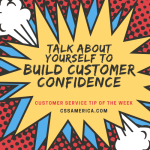 Have you ever walked into a patient registration area of a hospital and seen a sign that said “if you’ve been waiting longer than 15 minutes, please see the receptionist?”
Have you ever walked into a patient registration area of a hospital and seen a sign that said “if you’ve been waiting longer than 15 minutes, please see the receptionist?”
Have you ever called a customer service number and been told by a recording that “the average hold time is ‘X’ minutes?”
Have you ever begun the process of getting a permit to build a deck on a home and been given a form that says what each step in the process involves, when you need to do each step (including inspections), and whom you need to contact?
You may reply “no” to all of these or “yes” to some, but these are examples of companies who understand the importance of trying to set or manage customer expectations. These companies understand that that first person may complain after waiting 5 minutes if they don’t realize that a 15-minute wait is realistic. These companies realize that that second customer may get irate or take their business elsewhere if they had to wait on the phone 2 minutes but might be more patient if their expectation is a 3-minute wait. These companies understand that a customer educated on a process is more comfortable and less likely to have issues with it, less likely to do things incorrectly.
Companies who attempt to proactively set or manage expectations understand the importance of the customer having some concept in their mind of what the reality is going to be; that makes it more likely that the customer will be satisfied with the experience, and the employee won’t have to deal with an irate customer.
Where can your company proactively set an expectation with customers about how long a process will take, how long a wait might be, what actions are about to take place, or what they need to do?
Determine where the opportunities to set expectations exist, and then use signage, messaging, documentation, and direct one-on-one conversations to do whatever you can to set (or reset) your customers’ expectations.
Get customer expectations back to reality.
Signup for FREE Tips! Contact Us More Resources for You Visit Our Home Page














 The customer was throwing an absolute fit in the lobby. Sitting among several other customers waiting for her number to be called, she was raising her voice and letting out the occasional expletive about the lengthy wait time. An employee sitting behind the counter thought to herself: I’m going to ignore her and not make eye contact and hope somebody else deals with her.
The customer was throwing an absolute fit in the lobby. Sitting among several other customers waiting for her number to be called, she was raising her voice and letting out the occasional expletive about the lengthy wait time. An employee sitting behind the counter thought to herself: I’m going to ignore her and not make eye contact and hope somebody else deals with her. Libby was new to her role with the organization. She had never been a customer service representative in a call center before, but she was hired because of her attitude. She wanted to learn, enjoyed working with people, and could carry on a conversation with a wall.
Libby was new to her role with the organization. She had never been a customer service representative in a call center before, but she was hired because of her attitude. She wanted to learn, enjoyed working with people, and could carry on a conversation with a wall.






